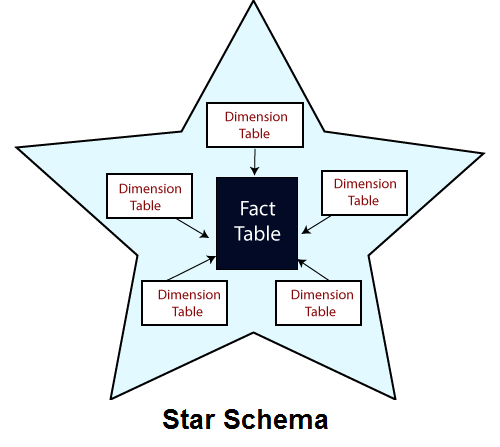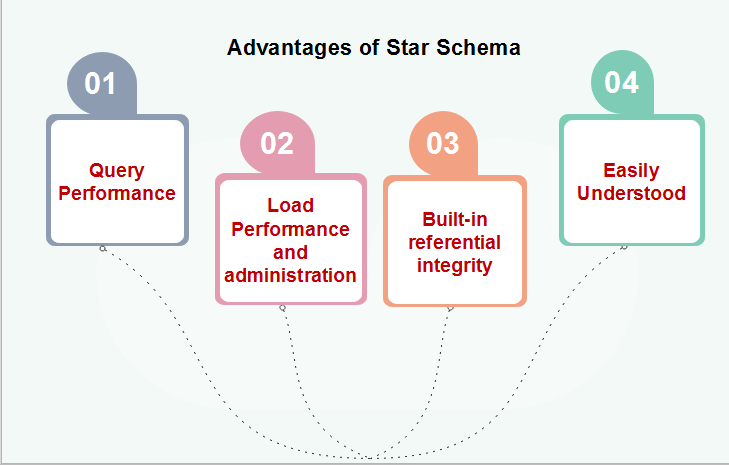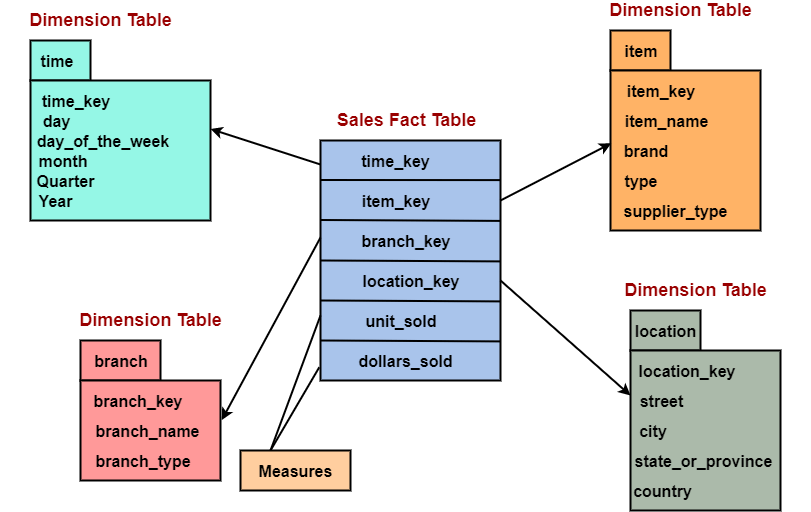What is Star Schema?A star schema is the elementary form of a dimensional model, in which data are organized into facts and dimensions. A fact is an event that is counted or measured, such as a sale or log in. A dimension includes reference data about the fact, such as date, item, or customer. A star schema is a relational schema where a relational schema whose design represents a multidimensional data model. The star schema is the explicit data warehouse schema. It is known as star schema because the entity-relationship diagram of this schemas simulates a star, with points, diverge from a central table. The center of the schema consists of a large fact table, and the points of the star are the dimension tables. 
Fact TablesA table in a star schema which contains facts and connected to dimensions. A fact table has two types of columns: those that include fact and those that are foreign keys to the dimension table. The primary key of the fact tables is generally a composite key that is made up of all of its foreign keys. A fact table might involve either detail level fact or fact that have been aggregated (fact tables that include aggregated fact are often instead called summary tables). A fact table generally contains facts with the same level of aggregation. Dimension TablesA dimension is an architecture usually composed of one or more hierarchies that categorize data. If a dimension has not got hierarchies and levels, it is called a flat dimension or list. The primary keys of each of the dimensions table are part of the composite primary keys of the fact table. Dimensional attributes help to define the dimensional value. They are generally descriptive, textual values. Dimensional tables are usually small in size than fact table. Fact tables store data about sales while dimension tables data about the geographic region (markets, cities), clients, products, times, channels. Characteristics of Star SchemaThe star schema is intensely suitable for data warehouse database design because of the following features:
Advantages of Star SchemaStar Schemas are easy for end-users and application to understand and navigate. With a well-designed schema, the customer can instantly analyze large, multidimensional data sets. The main advantage of star schemas in a decision-support environment are: 
Query PerformanceA star schema database has a limited number of table and clear join paths, the query run faster than they do against OLTP systems. Small single-table queries, frequently of a dimension table, are almost instantaneous. Large join queries that contain multiple tables takes only seconds or minutes to run. In a star schema database design, the dimension is connected only through the central fact table. When the two-dimension table is used in a query, only one join path, intersecting the fact tables, exist between those two tables. This design feature enforces authentic and consistent query results. Load performance and administrationStructural simplicity also decreases the time required to load large batches of record into a star schema database. By describing facts and dimensions and separating them into the various table, the impact of a load structure is reduced. Dimension table can be populated once and occasionally refreshed. We can add new facts regularly and selectively by appending records to a fact table. Built-in referential integrityA star schema has referential integrity built-in when information is loaded. Referential integrity is enforced because each data in dimensional tables has a unique primary key, and all keys in the fact table are legitimate foreign keys drawn from the dimension table. A record in the fact table which is not related correctly to a dimension cannot be given the correct key value to be retrieved. Easily UnderstoodA star schema is simple to understand and navigate, with dimensions joined only through the fact table. These joins are more significant to the end-user because they represent the fundamental relationship between parts of the underlying business. Customer can also browse dimension table attributes before constructing a query. Disadvantage of Star SchemaThere is some condition which cannot be meet by star schemas like the relationship between the user, and bank account cannot describe as star schema as the relationship between them is many to many. Example: Suppose a star schema is composed of a fact table, SALES, and several dimension tables connected to it for time, branch, item, and geographic locations. The TIME table has a column for each day, month, quarter, and year. The ITEM table has columns for each item_Key, item_name, brand, type, supplier_type. The BRANCH table has columns for each branch_key, branch_name, branch_type. The LOCATION table has columns of geographic data, including street, city, state, and country. 
In this scenario, the SALES table contains only four columns with IDs from the dimension tables, TIME, ITEM, BRANCH, and LOCATION, instead of four columns for time data, four columns for ITEM data, three columns for BRANCH data, and four columns for LOCATION data. Thus, the size of the fact table is significantly reduced. When we need to change an item, we need only make a single change in the dimension table, instead of making many changes in the fact table. We can create even more complex star schemas by normalizing a dimension table into several tables. The normalized dimension table is called a Snowflake.
Next TopicWhat is Snowflake Schema
|
 For Videos Join Our Youtube Channel: Join Now
For Videos Join Our Youtube Channel: Join Now
Feedback
- Send your Feedback to [email protected]
Help Others, Please Share










